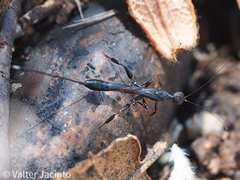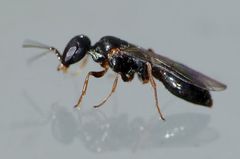Sirex woodwasp
Sirex noctilio
Sirex noctilio, commonly known as the Woodwasp or Horntail, is a species of horntail native to Europe, Asia, and North Africa. It is an invasive pest in other regions such as North America, South Africa, Australia, and parts of South America, where it causes significant damage to pine forests.
Here are some key characteristics of Sirex noctilio:
- Appearance: Adult woodwasp are large insects, ranging from 1.5 to 4 cm in length. They have a cylindrical body with a metallic blue-black color. Males can be distinguished by their orange legs and bands, while females are generally larger with a prominent ovipositor used for laying eggs.
- Life Cycle: The lifecycle comprises egg, larva, pupa, and adult stages. Females lay eggs in the bark of host trees, often injecting a symbiotic fungus and toxic mucus that helps larvae feed on the wood. This process causes the tree's decay, facilitating larval growth.
- Habitat: Sirex noctilio primarily affects coniferous trees, with a particular preference for weakened or stressed pine trees. It may be found in a variety of forest settings, from natural woodlands to commercial plantations.
- Impact: This species is considered a major forestry pest due to its ability to weaken and kill trees, which leads to economic losses in affected areas. Management strategies often include the use of biological control agents that target the wasp's larvae and the fungal symbiote.
- Local Context: In the Comunidad Valenciana, where pine forests are prevalent, monitoring and controlling Sirex noctilio populations is essential to maintain forest health and biodiversity.
Understanding and awareness of Sirex noctilio are critical for managing its spread and mitigating its impact on local ecosystems and economies.







